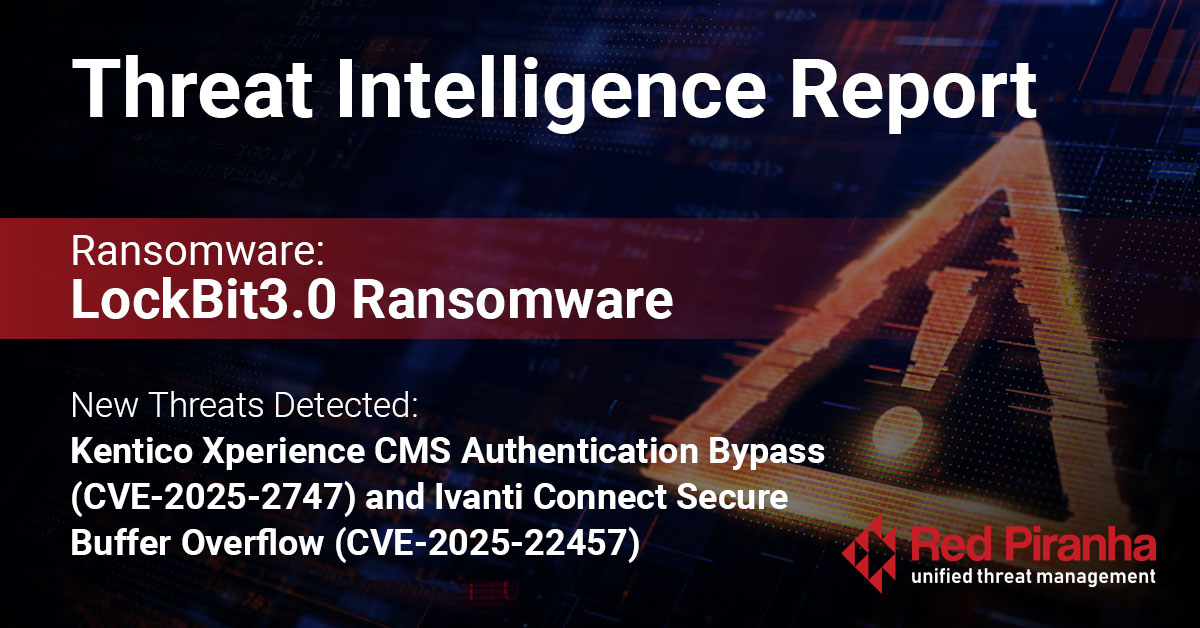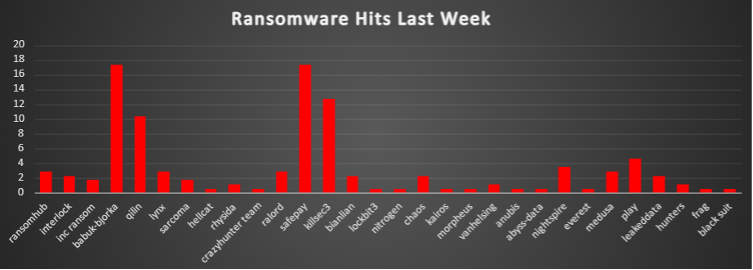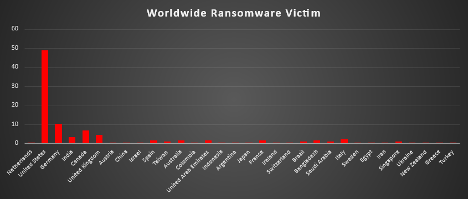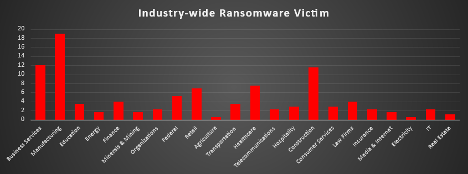
| New Threat Detection Added | 2 - Kentico Xperience CMS Authentication Bypass (CVE-2025-2747) , Ivanti Connect Secure Buffer Overflow (CVE-2025-22457) |
| New Threat Protections | 133 |
Weekly Detected Threats
The following threats were added to Crystal Eye this week:
Threat name: | Kentico Xperience CMS Authentication Bypass (CVE-2025-2747) | ||||||||||||||||||
This authentication bypass vulnerability affects Kentico Xperience CMS versions up to 13.0.178. This vulnerability allows a threat actor to bypass account authentication for the Xperience CMS through the Staging Sync Server component. This allows the threat actor to control administrative objects. | |||||||||||||||||||
Threat Protected: | 04 | ||||||||||||||||||
Rule Set Type: |
| ||||||||||||||||||
Class Type: | Attempted-admin | ||||||||||||||||||
Kill Chain: |
| ||||||||||||||||||
Threat name: | Ivanti Connect Secure Buffer Overflow (CVE-2025-22457) | ||||||||||||||||||
This vulnerability allows remote code execution via a buffer overflow on Ivanti Connect Secure, Pulse Connect Secure, Ivanti Policy Secure and ZTA Gateway. Threat actors can exploit this vulnerability to gain unauthorised access to the network and it has been observed that malware has been distributed through this vulnerability. | |||||||||||||||||||
Threat Protected: | 01 | ||||||||||||||||||
Rule Set Type: |
| ||||||||||||||||||
Class Type: | Web-application-attack | ||||||||||||||||||
Kill Chain: |
| ||||||||||||||||||
Known Exploited Vulnerabilities (Week 1 - April 2025)
For more information, please visit the Red Piranha Forum:
https://forum.redpiranha.net/t/known-exploited-vulnerabilities-catalog-2nd-week-of-april-2025/559
Vulnerability | CVSS | Description | |
CVE-2025-22457 | 9.0 (Critical) | Ivanti Connect Secure, Policy Secure and ZTA Gateways Stack-Based Buffer Overflow Vulnerability | |
CVE-2025-24813 | 9.8 (Critical) | Apache Tomcat Path Equivalence Vulnerability |
Updated Malware Signatures (Week 1 - April 2025)
Threat | Description | |
zgRAT | Is a trojan, usually deployed via USB devices or phishing emails that target browser information (Saved Login Details) and cryptowallets. | |
XWorm | A Remote Access Trojan (RAT) and malware loader commonly used in cyberattacks to give attackers complete remote control over a victim's system. It's part of a growing trend of commercialised malware sold or rented on dark web forums, often under the guise of a “legitimate tool.” |
| Ransomware Report | |
The Red Piranha Team conducts ongoing surveillance of the dark web and other channels to identify global organisations impacted by ransomware attacks. In the past week, our monitoring revealed multiple ransomware incidents across diverse threat groups, underscoring the persistent and widespread nature of these cyber risks. Presented below is a detailed breakdown of ransomware group activities during this period. | |
| Name of Ransomware Group | Overall %age of total attack coverage |
2.89% | |
Interlock | 2.31% |
Inc ransom | 1.73% |
Babuk-Bjorka | 17.34% |
10.4% | |
Lynx | 2.89% |
Sarcoma | 1.73% |
Hellcat | 0.58% |
1.16% | |
CrazyHunter Team | 0.58% |
Ralord | 2.89% |
17.34% | |
KillSec3 | 12.72% |
Bianlian | 2.31% |
0.58% | |
Nitrogen | 0.58% |
Chaos | 2.31% |
Kairos | 0.58% |
Morpheus | 0.58% |
VanHelsing | 1.16% |
Anubis | 0.58% |
Abyss-Data | 0.58% |
NightSpire | 3.47% |
Everest | 0.58% |
2.89% | |
4.62% | |
Leaked Data | 2.31% |
Hunters | 1.16% |
Frag | 0.58% |
0.58% | |

LockBit3.0 Ransomware Group
LockBit3.0 continues to assert its dominance as one of the most prolific ransomware operations globally. Operating under the Ransomware-as-a-Service (RaaS) model, LockBit enables affiliates to launch attacks using the group’s advanced encryption tools and infrastructure, allowing it to scale rapidly and efficiently. The group has been linked to nearly one-third of global ransomware attacks, with some estimates attributing 40% of all ransomware incidents to its affiliates.
A distinguishing feature of LockBit’s ecosystem includes a professional dark web portal, a victim leak site, and the only known ransomware-affiliated bug bounty program. The threat actors behind LockBit have iterated their malware through multiple versions — LockBit Red (2.0), and LockBit Black (3.0), and are now testing encryptors for macOS, Linux, and even rare architectures like SPARC and MIPS.
Attack Chain Analysis
Initial Access
LockBit affiliates typically gain entry via compromised credentials from phishing, unpatched software, or brute-forcing RDP/VPN services. Reconnaissance and exploitation are automated using off-the-shelf tools or custom scripts.
Lateral Movement
After gaining a foothold, attackers use native Windows utilities like PsExec, WMI, and RDP to pivot across systems. Access tokens and credentials are harvested using tools such as Mimikatz.
Execution
The payload often includes PowerShell stagers or obfuscated binary droppers. Recent variants also utilise Safe Mode Boot execution and command-line parameters for stealth operations.
Defence Evasion
LockBit employs multiple evasion tactics:
- Encrypted payloads
- Process hollowing
- Use of signed binaries (LOLBAS)
- Environment-aware checks to avoid sandboxes
Data Exfiltration and Impact
Data is exfiltrated via C2 infrastructure or secure cloud storage before encryption. Upon failure to pay, victims’ data is posted on LockBit’s leak portals hosted on the Tor network.
Detailed TTPs
Stage | Tactic | Technique | Description |
Initial Access | Valid Accounts (T1078) | Compromised VPN/RDP credentials | Gained access via brute-force or phishing credentials. |
Execution | Command & Scripting (T1059) | PowerShell, Batch, WMI execution | Used for launching loaders, scripts, and ransomware binary. |
Persistence | Boot or Logon AutoStart (T1547) | Safe Mode persistence | Reboots into Safe Mode to evade AVs before encryption. |
Privilege Escalation | Exploitation for Privilege (T1068) | Custom exploits or LOLBins | Exploited system services or misconfigurations to elevate privileges. |
Defence Evasion | Obfuscated Files/Info (T1027) | Encrypted & XOR payloads | Avoided detection by obfuscating code & using signed binaries. |
Credential Access | Credential Dumping (T1003) | LSASS dumping via Mimikatz | Extracted hashes, tokens, and plaintext passwords. |
Lateral Movement | Remote Services (T1021) | RDP, SMB, PsExec | Moved laterally using valid credentials and built-in tools. |
Impact | Data Encrypted for Impact (T1486) | Ransomware payloads | Locked files using AES/RSA-based encryption. |
Exfiltration | Exfiltration Over Web (T1041) | C2 channel or leak site staging | Uploaded data to attacker-controlled servers before encryption. |
Mitigations Against LockBit Ransomware
- Harden External Interfaces
Disable or strictly limit RDP and VPN exposure. Enforce strong passwords and MFA on all remote access points. - Patch Management
Regularly update software and operating systems to close known vulnerabilities, particularly those exploited in privilege escalation or lateral movement. - Network Segmentation
Implement VLANs or zero-trust architectures to limit lateral movement. Isolate backup systems entirely. - Application Whitelisting & EDR/XDR
Deploy next-gen AV/EDR solutions with behaviour-based detections. Use tools like AppLocker or WDAC to block unauthorised executables. - Credential Protection
Prevent credential theft by enforcing LSASS protections, disabling legacy protocols (e.g., SMBv1), and rotating domain admin passwords.
Ransomware Victims Worldwide
A recent ransomware threat landscape analysis reveals that the United States remains the most significantly impacted nation, accounting for a substantial 48.85% of global incidents. This highlights the persistent targeting of US-based organisations by increasingly sophisticated ransomware operations.
Germany emerges as the second-most affected country, reporting 10.34% of global incidents, followed by Canada at 6.9%, and the United Kingdom at 4.6%. These figures signal an intensifying focus on key Western economies. Meanwhile, India reports 3.45% of global cases, demonstrating the spread of ransomware campaigns into South Asia.
Several other countries have experienced moderate levels of ransomware activity, including Italy (2.3%), Bangladesh (1.72%), France (1.72%), Australia (1.72%), Spain (1.72%), and the United Arab Emirates (1.72%), reflecting a broader geographic distribution of ransomware attacks across Europe, Asia, and the Middle East.
Nations reporting 1.15% of incidents each include Brazil, Saudi Arabia, Taiwan, and Singapore — suggesting that even technologically advanced or geographically distant countries are not immune to these threats.
Several countries recorded lower yet notable percentages of ransomware activity, each contributing 0.57% of global incidents. These include the Netherlands, Austria, China, Israel, Colombia, Indonesia, Argentina, Japan, Ireland, Switzerland, Sweden, Egypt, Iran, Ukraine, New Zealand, Greece, and Turkey.
This global distribution of ransomware incidents underscores the widening scope and international scale of cybercriminal operations. The findings highlight the urgent need for coordinated cybersecurity efforts, including cross-border intelligence sharing, robust threat detection capabilities, and resilient incident response plans to mitigate the escalating risk posed by ransomware threats.

Ransomware Victims by Industry
In the most recent industry-specific analysis of ransomware activity, the Manufacturing sector has emerged as the most targeted, accounting for 18.97% of global incidents. This continues to highlight the pressing vulnerabilities in industrial control systems, production infrastructure, and interconnected supply chains.
Business Services followed with 12.07%, signalling a sustained ransomware focus on service-based and consulting organisations that handle large volumes of client data. The Construction industry ranked third, with 11.49% of incidents, reflecting ongoing exposure among engineering, infrastructure, and development firms.
Other heavily impacted sectors include Healthcare (7.47%) and Retail (6.9%), underscoring the targeting of sensitive patient records and consumer data. Notably, the Federal sector reported 5.17% of incidents, emphasising the growing threat to governmental and public agencies.
Finance (4.02%) and Law Firms (4.02%) remain high-value targets due to their concentration of confidential financial and legal data. Sectors such as Education (3.45%), Transportation (3.45%), and Hospitality (2.87%) also saw considerable ransomware activity, revealing attackers’ interest in institutions providing essential services.
Emerging concerns were observed in industries like Telecommunications (2.3%), Consumer Services (2.87%), Organisations (2.3%), Insurance (2.3%), and IT (2.3%), indicating a shift toward digital service providers and policy-driven data holders.
Lower but still notable targeting was seen in Real Estate (1.15%), Energy (1.72%), Media & Internet (1.72%), and Minerals & Mining (1.72%), as threat actors diversify across operationally critical sectors. Agriculture (0.57%) and Electricity (0.57%) were also affected, proving that even traditionally offline industries are not immune.
This analysis affirms that ransomware attacks remain indiscriminate and opportunistic, affecting both critical infrastructure and commercial enterprises. The growing breadth of targeted sectors reinforces the necessity for industry-specific cybersecurity frameworks, enhanced intrusion detection mechanisms, and robust incident response plans to combat these evolving threats.

